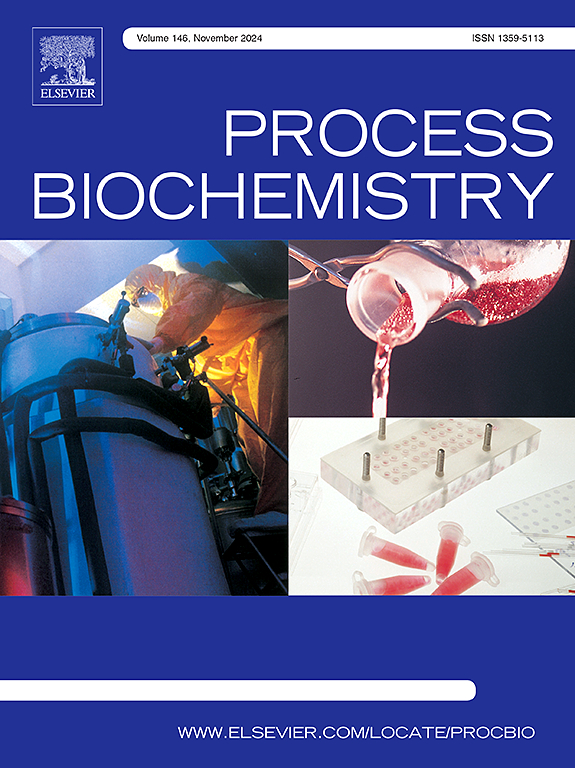Statistical optimization of production and characterization of biosurfactant produced by Lactobacillus plantarum JBC5 strain in a ghee (clarified butter) medium: Assessment of its antimicrobial activity and stain removal property
IF 4
3区 生物学
Q2 BIOCHEMISTRY & MOLECULAR BIOLOGY
引用次数: 0
Abstract
This investigation focused on optimizing and characterizing a biosurfactant derived from Lactobacillus plantarum JBC5, which was isolated from local curd. Ghee, a clarified butter that has not previously been explored as a substrate, was used for biosurfactant production. The Plackett-Burman factorial design identified significant parameters affecting bacterial growth and biosurfactant production, whereas response surface methodology (RSM) predicted optimal production at 3.2 g/L ± 0.08 g/L, which was experimentally validated at 3.1 ± 0.09 g/L.The column-purified biosurfactant demonstrated a critical micelle concentration of 100 mg/L, reducing water's surface tension to 34.0 ± 0.03 mN/m. The emulsification index (E24) of biosurfactants with edible oils was 59.8 %, making them a viable alternative to synthetic surfactants. Lipopeptide composition of biosurfactant was confirmed using nuclear magnetic resonance (NMR) and liquid chromatography-mas spectrometry analyses (LC-MS). Thermal analyses showed excellent heat stability as the crystallization and melting points were determined at 95.68°C and 276.72°C, respectively, suggesting its suitability for high-temperature industrial use. Combined with commercial facewash, the biosurfactant improved wash performance, as evidenced by increased post-wash solution absorbance. Antibacterial assay of biosurfactant showed bacteriostatic action against Staphylococcus aureus, with 61.3 % growth inhibition at 500 μg/mL. These findings position the biosurfactant as a promising candidate for cosmetic and industrial applications.
植物乳杆菌JBC5菌株在酥油(澄清黄油)培养基中生产生物表面活性剂的统计优化及其特性:抑菌活性和去污性能的评估
本研究主要对从植物乳杆菌JBC5中分离得到的生物表面活性剂进行了优化和表征。酥油是一种澄清的黄油,以前没有作为底物进行过探索,被用于生产生物表面活性剂。placket - burman析因设计确定了影响细菌生长和生物表面活性剂产量的显著参数,而响应面法(RSM)预测的最佳产量为3.2 g/L ± 0.08 g/L,实验验证的产量为3.1 ± 0.09 g/L。柱纯化生物表面活性剂的临界胶束浓度为100 mg/L,使水的表面张力降至34.0 ± 0.03 mN/m。生物表面活性剂对食用油的乳化指数(E24)为59.8 %,是一种可行的替代合成表面活性剂的方法。采用核磁共振(NMR)和液相色谱-质谱(LC-MS)分析确定了生物表面活性剂的脂肽组成。热分析表明,该材料的结晶和熔点分别为95.68°C和276.72°C,具有良好的热稳定性,适合高温工业应用。与商业洗面奶相结合,生物表面活性剂改善了洗涤性能,洗涤后溶液吸收度增加。抑菌实验表明,生物表面活性剂对金黄色葡萄球菌有抑菌作用,500 μg/mL时对金黄色葡萄球菌的生长抑制率为61.3 %。这些发现使生物表面活性剂成为化妆品和工业应用的有前途的候选者。
本文章由计算机程序翻译,如有差异,请以英文原文为准。
求助全文
约1分钟内获得全文
求助全文
来源期刊

Process Biochemistry
生物-工程:化工
CiteScore
8.30
自引率
4.50%
发文量
374
审稿时长
53 days
期刊介绍:
Process Biochemistry is an application-orientated research journal devoted to reporting advances with originality and novelty, in the science and technology of the processes involving bioactive molecules and living organisms. These processes concern the production of useful metabolites or materials, or the removal of toxic compounds using tools and methods of current biology and engineering. Its main areas of interest include novel bioprocesses and enabling technologies (such as nanobiotechnology, tissue engineering, directed evolution, metabolic engineering, systems biology, and synthetic biology) applicable in food (nutraceutical), healthcare (medical, pharmaceutical, cosmetic), energy (biofuels), environmental, and biorefinery industries and their underlying biological and engineering principles.
 求助内容:
求助内容: 应助结果提醒方式:
应助结果提醒方式:


